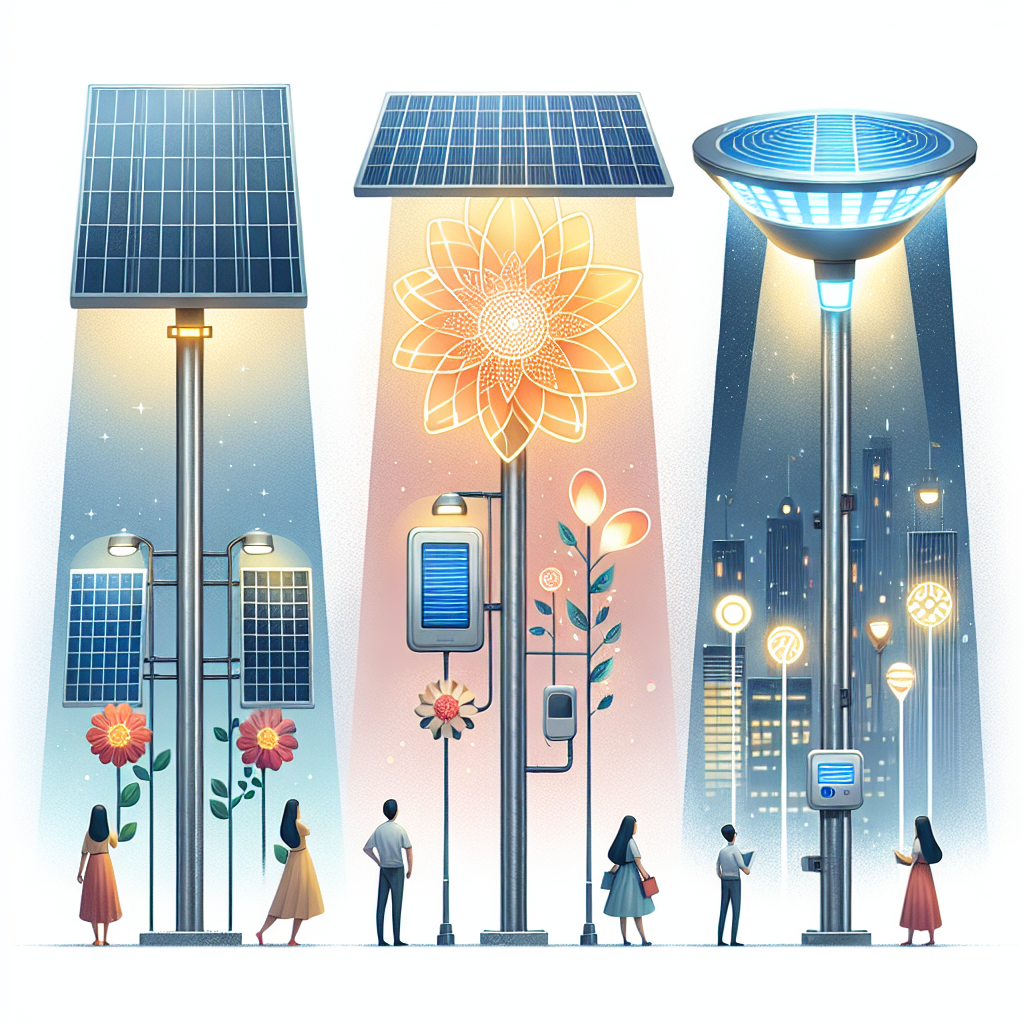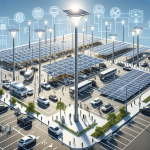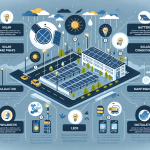Types of Solar Carpark Lights
Table of Contents
Solar carpark lights are an innovative and sustainable solution for illuminating parking areas using solar energy. These lights harness the power of the sun through photovoltaic panels, converting sunlight into electricity to power LED fixtures. There are several types of solar carpark lights, each designed to meet specific needs and conditions. The main types include:
1. Standalone Solar Carpark Lights : These are self-contained units with integrated solar panels, batteries, and LED lights. They are easy to install and require no external wiring, making them ideal for remote or off-grid locations.
2. Grid-Tied Solar Carpark Lights: These systems are connected to the electrical grid, allowing for the use of solar power during the day and grid power at night or during cloudy conditions. They offer a reliable lighting solution with reduced energy costs.
3. All-in-One Solar Carpark Lights: Combining the solar panel, battery, and LED light into a single compact unit, these lights are designed for easy installation and maintenance. They are often equipped with motion sensors and smart controls to optimize energy usage.
4. Solar Canopy Carpark Lights: Installed on carport structures, these lights provide both shade and illumination. The solar panels are mounted on the canopy roof, generating electricity to power the lights and potentially other applications, such as electric vehicle charging stations.
5. Hybrid Solar Carpark Lights: These systems combine solar power with other renewable energy sources, such as wind or kinetic energy, to ensure continuous operation even in less sunny conditions. They are suitable for areas with variable weather patterns.
Each type of solar carpark light offers unique benefits, from ease of installation and maintenance to enhanced energy efficiency and sustainability. By choosing the appropriate type, businesses and municipalities can improve safety, reduce energy costs, and contribute to environmental conservation.
Advantages Of Integrated Solar Carpark Lights
Integrated solar carpark lights offer a multitude of advantages that make them an increasingly popular choice for both public and private parking facilities. One of the primary benefits of these lights is their energy efficiency. Unlike traditional lighting systems that rely on electricity from the grid, integrated solar carpark lights harness energy from the sun. This not only reduces the overall energy consumption but also significantly lowers electricity bills. By utilizing renewable energy, these lights contribute to a reduction in carbon footprint, aligning with global efforts to combat climate change.
In addition to energy efficiency, integrated solar carpark lights are known for their ease of installation. Traditional lighting systems often require extensive wiring and trenching, which can be both time-consuming and costly. In contrast, solar carpark lights are typically designed to be self-contained units, incorporating solar panels, batteries, and LED lights into a single fixture. This design simplifies the installation process, as there is no need for complex electrical work. Consequently, the installation can be completed more quickly and with less disruption to the parking facility.
Another significant advantage of integrated solar carpark lights is their low maintenance requirements. Traditional lighting systems often require regular maintenance, including bulb replacements and electrical inspections. However, solar carpark lights are designed to be durable and long-lasting, with many models featuring LED lights that can last for tens of thousands of hours. The use of high-quality materials and advanced technology ensures that these lights can withstand harsh weather conditions, reducing the need for frequent maintenance and associated costs.
Furthermore, integrated solar carpark lights offer enhanced safety and security. Well-lit parking areas are crucial for the safety of both pedestrians and vehicles. Solar carpark lights provide consistent and reliable illumination, ensuring that parking areas are well-lit even during power outages. This continuous lighting helps to deter criminal activities and enhances the overall sense of security for users of the parking facility. Additionally, many integrated solar carpark lights come equipped with motion sensors, which can further enhance security by activating the lights only when movement is detected.
The environmental benefits of integrated solar carpark lights cannot be overstated. By relying on solar energy, these lights reduce the demand for fossil fuels and decrease greenhouse gas emissions. This makes them an environmentally friendly option that supports sustainable development goals. Moreover, the use of solar energy helps to conserve natural resources and reduces the strain on the electrical grid, contributing to a more sustainable and resilient energy system.
Cost-effectiveness is another compelling advantage of integrated solar carpark lights. While the initial investment may be higher compared to traditional lighting systems, the long-term savings are substantial. The reduction in electricity bills, coupled with lower maintenance costs, results in significant financial savings over the lifespan of the lights. Additionally, many governments and organizations offer incentives and rebates for the installation of solar lighting systems, further enhancing their cost-effectiveness.
In conclusion, integrated solar carpark lights offer a range of advantages that make them an attractive option for modern parking facilities. Their energy efficiency, ease of installation, low maintenance requirements, enhanced safety and security, environmental benefits, and cost-effectiveness collectively contribute to their growing popularity. As technology continues to advance, it is likely that the adoption of integrated solar carpark lights will continue to increase, supporting the transition to more sustainable and energy-efficient lighting solutions.
Comparing Motion Sensor Vs. Dusk-To-Dawn Solar Carpark Lights

When considering the implementation of solar carpark lights, it is essential to understand the different types available and their respective functionalities. Two prominent types of solar carpark lights are motion sensor lights and dusk-to-dawn lights. Each type offers unique advantages and is suited to different applications, making it crucial to compare their features to determine the most appropriate choice for specific needs.
Motion sensor solar carpark lights are designed to activate when they detect movement within a certain range. This feature makes them highly efficient in terms of energy consumption, as the lights only operate when necessary. The primary advantage of motion sensor lights is their ability to provide illumination precisely when and where it is needed, thereby conserving energy and extending the lifespan of the lighting system. Additionally, the sudden activation of lights can serve as a deterrent to potential intruders, enhancing the security of the carpark. However, it is important to note that the effectiveness of motion sensor lights can be influenced by environmental factors such as weather conditions and the presence of obstructions, which may affect the sensors’ ability to detect movement accurately.
In contrast, dusk-to-dawn solar carpark lights operate on a different principle. These lights are equipped with sensors that detect the ambient light levels, automatically turning the lights on at dusk and off at dawn. This type of lighting ensures consistent illumination throughout the night, providing a reliable and continuous source of light. One of the main benefits of dusk-to-dawn lights is their ability to enhance safety and visibility in the carpark, making it easier for drivers and pedestrians to navigate the area during nighttime hours. Furthermore, the consistent lighting can contribute to a sense of security, as it eliminates dark spots that could potentially be exploited by wrongdoers.
While both motion sensor and dusk-to-dawn solar carpark lights offer significant advantages, the choice between the two ultimately depends on the specific requirements of the carpark in question. For instance, in a carpark with low traffic during nighttime hours, motion sensor lights may be more suitable due to their energy-saving capabilities. On the other hand, in a carpark that experiences high traffic or requires constant illumination for safety reasons, dusk-to-dawn lights may be the better option.
It is also worth considering the maintenance and installation aspects of these lighting systems. Motion sensor lights may require periodic adjustments to ensure the sensors are functioning correctly and are not obstructed by debris or other objects. Conversely, dusk-to-dawn lights generally require less maintenance, as their operation is based on ambient light levels rather than movement detection. However, both types of lights benefit from regular cleaning of the solar panels to ensure optimal energy absorption and performance.
In conclusion, the decision between motion sensor and dusk-to-dawn solar carpark lights should be guided by the specific needs and conditions of the carpark. Motion sensor lights offer energy efficiency and enhanced security through targeted illumination, while dusk-to-dawn lights provide consistent and reliable lighting throughout the night. By carefully evaluating the advantages and limitations of each type, carpark managers can make an informed decision that best meets their lighting requirements and contributes to a safer and more efficient environment.
Installation Tips For Standalone Solar Carpark Lights
When considering the installation of standalone solar carpark lights, it is essential to approach the process with a comprehensive understanding of the various factors that can influence the effectiveness and longevity of the lighting system. Proper installation not only ensures optimal performance but also maximizes the return on investment. To begin with, selecting an appropriate location is paramount. The chosen site should receive ample sunlight throughout the day, as the efficiency of solar panels is directly proportional to the amount of sunlight they absorb. Avoiding shaded areas, such as those under trees or near tall buildings, is crucial to ensure that the solar panels can capture sufficient solar energy.
Once the location is determined, the next step involves preparing the site. This includes ensuring that the ground is stable and level, which is vital for the structural integrity of the light poles. In some cases, it may be necessary to use concrete foundations to provide additional support, especially in areas prone to high winds or other adverse weather conditions. Additionally, it is important to consider the height of the light poles. Taller poles can illuminate a larger area but may require more robust foundations and support structures.
Transitioning to the installation of the solar panels, it is essential to position them at an angle that maximizes their exposure to sunlight. The optimal angle can vary depending on the geographical location, but a general rule of thumb is to tilt the panels at an angle equal to the latitude of the installation site. This ensures that the panels receive the maximum amount of sunlight throughout the year. Furthermore, it is advisable to periodically clean the solar panels to remove any dust, dirt, or debris that may accumulate and hinder their efficiency.
In addition to the solar panels, the installation of the battery storage system is a critical component of standalone solar carpark lights. The batteries store the energy generated by the solar panels during the day and supply power to the lights at night. It is important to install the batteries in a secure, weatherproof enclosure to protect them from environmental factors such as rain, snow, and extreme temperatures. Moreover, regular maintenance checks should be conducted to ensure that the batteries are functioning correctly and to replace them when necessary.
The final step in the installation process involves connecting the various components of the solar carpark lights, including the solar panels, batteries, and light fixtures. This requires careful attention to detail to ensure that all connections are secure and that the system is properly configured. It is advisable to follow the manufacturer’s instructions and, if necessary, consult with a professional installer to ensure that the system is set up correctly.
In conclusion, the successful installation of standalone solar carpark lights involves a series of carefully planned steps, from selecting an appropriate location to ensuring that all components are properly connected and maintained. By paying attention to these details, one can ensure that the solar carpark lights operate efficiently and reliably, providing a sustainable and cost-effective lighting solution for carparks.
Read more about Solar Carpark Lights:
- Introduction to Solar Carpark Lights
- Factors to Consider when Choosing Solar Carpark Lights
- Installation and Maintenance of Solar Carpark Lights
- Top Brands in the Solar Carpark Light Industry
- Innovative Features of Solar Carpark Lights
- Case Studies: Successful Implementation of Solar Carpark Lights
- Practical Applications of Solar Carpark Lights
- Future Developments in Solar Carpark Lights
- Frequently Asked Questions about Solar Carpark Lights









